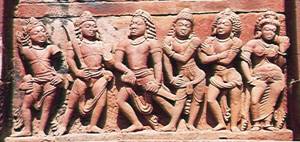Content
- 1 Forms 1.1 Fraternal polyandry
- 1.2 Multiple paternity
- 1.3 Biandria
- 1.4 Polygynandry
- 2.1 Asia
- 3.1 Hinduism
Countries allowing same-sex marriage
First, it’s worth understanding the difference between registering a marriage at the registry office and registering a civil partnership. In countries where same-sex marriage is legal, homosexuals can have a full wedding, like heterosexual couples, and also register their relationship in the same form. If the state prohibits marriage, it can offer an alternative option - a civil partnership. This was done in order to form a separate social institution recognized at the state level.
Now let's look at countries that allow same-sex marriage, where a husband and husband or wife and wife can create a full-fledged family and receive the same legal rights as couples of traditional sexual orientation. And also countries with civil partnerships.
| Countries that allow same-sex marriage | Countries that allow civil partnerships | |
|
|
|
There are several countries that allow civil cohabitation for same-sex couples:
- Croatia;
- Cyprus.
In some places, a decision is provided for the recognition of same-sex marriage on the territory of a state where this is not provided for by law, if the relationship was registered in a country where this is permitted. But some states do not allow marriage or partnership between citizens of other countries. The only way out is to marry a foreigner who is a citizen of a country where same-sex marriage is acceptable.
Forms
Fraternal polyandry
Fraternal polyandry (Greek φρατρία - brotherhood) is a form of polyandry in which the husbands of one woman are brothers to each other. It was common and is still occasionally found in central Tibet, Nepal and northern India,[9] where it was socially accepted.[5][10] In southern India, fraternal polyandry is practiced by the Toda tribe, but monogamy now prevails among them.[11] In modern Indian society, polyandrous marriages are observed in rural communities in the Malwa region. Punjab, which appears to be practiced there for the same purpose - to avoid fragmentation of farmers' land.[12]
In contrast to the European rules of primogeniture and primogeniture, which forced the younger sons of landowners to leave their native places and look for other occupations, fraternal polyandry allows not only to avoid fragmentation of estates during inheritance, but also makes it possible for brothers to stay and farm together. And in the next generation, their sons, born from a common wife, will also be able to marry one woman together and inherit the same plot of land, which will not be divided and will be provided with a sufficient amount of male labor [13]. But with a large number of brothers, this life strategy is less successful[14].
In the families of aristocrats and large landowners, polyandry can serve to preserve the titles and lands of the family. In the event of a long or frequent absence of one of the brothers, others can replace him, and the farm will not fall into decay without a responsible owner. In Tibet, polyandry was especially common among the spiritual elite of the Sakya school.
A prerequisite for polyandry may also be extreme gender inequality. For example, selective abortions in India lead to a shortage of women and to the “socialization” of the wife by several men (most often relatives)[15].
In polygynous marriages, an analogue of fraternal polyandry is sororate - the marriage of one man with several siblings or cousins.
Multiple paternity
Anthropologist Stephen Beckerman notes that in at least 20 tribal societies it is considered normal or even desirable for a child to have more than one father. This is called multiple (shared, partial, joint) paternity.[16] Often (but not always) the joint raising of a child by several fathers is associated with a polyandrous marriage of these men with the child's mother.[17]
One of the most famous examples of partial paternity is the “virgin birth” of all children, which is believed by some Trobriand Islanders. These people are aware of the need for sexual intercourse to give birth to a child, but at the same time they believe that a man has no influence on the child’s physique and personal qualities, which depend only on the mother. Therefore, they adopt inheritance exclusively through the maternal line (matrilineality), the child always belongs only to the mother’s clan. The mother's husbands who do not live in the same house with her are not considered the fathers of the child, but the mother's brothers who live with her are considered.
Biandria
Biandry is a type of polyandry
(from Latin bis - twice, and other Greek ἀνήρ - husband) - a form of marriage in which a woman has two husbands at the same time[18].
Polygynandry
In the Indian Himalayas, a combination of polyandry and polygyny occurs: when two or more men are married to two or more of the same women at the same time. This form of group marriage is called polygynandry. Polygynandry also avoids land fragmentation, diversifies local economic activity, and reduces population growth[19].
“Sukhov, you say?”
The code is a code, but individual attempts to allow polygamy in modern Russia were still made. They were initiated by the leaders of Ingushetia and Chechnya. Formally, such attempts towards the Middle Ages were rejected. But in fact, polygamy has survived in the North Caucasus. Only secretly. Eyewitnesses of Caucasian rituals claim that a highlander enters into his first marriage with a woman in the registry office, and the rest - in the mosque. The situation is similar in Central Asia. Especially in Turkmenistan, whose authorities allowed local men to have more than one wife. I immediately remember the immortal “White Sun of the Desert” and Comrade Sukhov, along with the harem of the Basmach Abdullah. After all, the action of this film took place precisely in the Turkmen sands.
Distribution area
Polyandry occurred and occurs in relatively small areas of distribution, scattered across different parts of the world.
Asia
The earliest known evidence of polyandry is the edict of Uruinimgina, who ruled the Sumerian city-state of Lagash around 2319-2311. BC, about the abolition of biandric marriages[20] and the prohibition of polyandry under the threat of stoning a woman who has several husbands if this is recorded.[21]
In some cantons of ancient Media, a woman was allowed to have several (but not more than four) husbands at the same time.[22] In the Hephthalite State, fraternal polyandry was legalized and generally accepted. A married woman wore a hat with horns according to the number of spouses. If the husbands of one woman were not blood brothers, they fraternized with each other before marrying a common spouse.[23][24]
Polyandry has been hypothesized to exist in ancient (pre-Muslim) South Arabia.[25][26] Supposedly, there was a tradition then called Nikah Ijtimah, which allowed polyandry, but with the adoption of Islam by the Arabs, this tradition was condemned and stopped[27].
Polyandry in Tibet (English)Russian. was more common than in any other known society, and may still be practiced today. Nikolai Notovich in his book noted the existence of polyandry in “Little Tibet” - Ladakh.[28] According to a study conducted in 1981 in Muli Tibet Autonomous County, 52% of marriages were monogamous, 32% of cases were fraternal polyandry, and 16% were polygyny in the form of sororate.[29] The PRC authorities, after establishing control over Tibet, outlawed polyandry, and due to the closed nature of this region and China as a whole, there is no reliable information about the number of polyandrous families in Tibet at the present time.[30] In China, polyandry is also found among the Mosuo people in the provinces of Sichuan and Yunnan[31].
In India, Bhutan and northern Nepal, polyandry continues to exist among national and religious minorities. Widely distributed among the Sherpas.[32] In 1914, polyandry was the dominant form of marriage in Bhutan.[33] In modern Bhutan, polyandry is much less common, but is still practiced by the Minaro living in the Merak gewogs. and Sakteng (English) Russian. Dzongkhaga Trashigang.[34]
In India, polyandry is most common in Rajasthan, Ladakh, Zanskar and the Jaunsar-Bawar (Hindi जौनसार बावर) region of Uttarakhand among the Toda tribe[5][30].
Polyandry is or was found among the Nivkhs on Sakhalin[35] and the Eskimos in northern Eurasia.[25]
Africa
There are known cases of polyandry in Nigeria[30], especially in the Irigwe (Rigwe) tribe in the northern regions of this country: women of this tribe traditionally have several spouses, whom they call “in-laws.” Polyandry was common among the Maasai in Kenya and northern Tanzania[31][36]. In the Great Lakes region, polyandry was rare, while polygyny was quite common there.[37]
In August 2013, two men in Kenya signed a contract to marry the same woman with whom they were each having an affair. Kenyan legislation does not strictly prohibit polyandry, but it is not very accepted there at the moment[38].
Europe

, Baths of Diocletian, Rome)
According to Julius Caesar, the ancient Britons practiced the socialization of a wife by brothers, and less often by father and son.[39] According to Polybius, polyandry was prevalent among the inhabitants of Laconia.[40][41] There is a famous case in the history of the Roman Empire when a crowd of matrons burst into the Senate and with tears begged for a law allowing a woman to have two husbands.[42] On the tomb of Allia Potestas from ancient Perugia there is an inscription telling how she lived peacefully with two lovers, one of whom immortalized her name in a famous epigraphic eulogy that dates from around the second century AD.[43]
Oceania and island countries
Cases of polyandry were also noted in some Polynesian tribes before European contact,[44] but there they occurred only among women from the upper castes.[45] Among the Guanches, the first known inhabitants of the Canary Islands, polyandry was also accepted and practiced until the disappearance of this people[46].
In Sri Lanka, fraternal polyandry is officially permitted under the Kandyan Marriage law. To denote polyandry, they often use the euphemism “eka-ge-kama” (literally translated - “eating in the same house”)[47]. Associated Polyandry is also found in Sri Lanka - a form of marriage that begins as monogamous, but later the number of husbands of the wife increases (sometimes on the initiative of the wife)[48][49].
Polyandry is common among the Kanakas of New Caledonia[50] and the aborigines of the Marquesas Islands.[25][51] Friedrich Ratzel in his 1896 book “History of Mankind” stated that in the New Hebrides polyandry was accepted among widowers and widowers: according to the custom of the locals tribes, two widowers had to live with one widow[52].
North America
Among the indigenous inhabitants of North America, polyandry was found among the Aleuts[25][53] (noted in the 19th century) and the Inuit.[54]
South America
In Brazil, polyandry is found among the Zo'é people living on the banks of the Cuminapanema River in the state of Pará[55]. Among other indigenous peoples of South America, polyandry is noted among the Bororo,[56] fraternal polyandry is accepted in the uncontacted Tupi-Kawahib tribe
),[57] and multiple paternity occurs in about 70% of Amazonian cultures.[58]
How long has same-sex marriage been legal?
To answer this question, it is worth turning to history and terminology. Let's first understand how the terms “homosexuality” and “homosexuality” differ. The first word evokes rather negative associations, since the suffix -ism is usually used in words denoting a disease. The term was demedicalized (removed from the medical context) in 1998. Since homosexuality was excluded from the international list of diseases ICD-10. That is, at the end of the twentieth century, scientists confirmed that non-traditional sexual orientation is not a disease.
After the 1998 event, homosexuals, mainly in Europe and the United States, began to take active steps to legalize same-sex marriage. And already in 2001, the first country where they were allowed was the Netherlands. Around this time, the term "homosexuality" was replaced by the more neutral word "homosexuality", and homosexuals began to be called homosexuals.

Is same-sex marriage legal everywhere? No, since the legalization of registration of such relationships has a different nature in different states. Let's figure out which countries allow same-sex marriages, and where alternative types of civil partnerships are allowed.

Polyandry and religion
Hinduism

Bhima, Arjuna, Yudhisthira, Nakula, Sahadeva, Draupadi. Dasavatar Temple (Deogarh village, Lalitpur district, Uttar Pradesh, India)
Polyandrous relationships are now frowned upon in most schools of Hinduism.[59] But in the ancient epic sacred to Hindus - the Mahabharata - there is at least one example of polyandry: Draupadi was married to five brothers from the Pandava family. This ancient text expresses a rather neutral attitude towards polyandry, which is accepted as Draupadi's way of life[60]. In the same epic, Yudhishthira, answering Kunti's questions about polyandry, refers to the Gautam-clan Jatila
), who was married to the seven Saptarishas, and to Praceti, the sister of Hiranyaksha, who was the common wife of ten brothers. As can be understood from this, in Vedic times society was much more accepting of polyandry.[61]
Judaism
There is no mention in the Hebrew biblical texts of any woman being the wife of more than one man at the same time,[62][63] and the biblical definition of adultery clearly states that polyandry is unacceptable.[64][65] There is no polyandry in Jewish traditions and customs.[66][67] In addition, children from any man other than the first husband are considered illegitimate (mamzers), unless the first husband has already divorced the woman or died[68].
Christianity
The vast majority of modern Christian denominations advocate strict monogamy and do not accept any other form of marriage, including polyandry. The New Testament (Rom. 7:2—) strictly prohibits polyandry.
Mormons
Mormon prophets Joseph Smith and Brigham Young set historical records for polygamy. There is a version that they also took women from other husbands, that is, they practiced polygynandry, but this issue remains controversial.[69]
Islam
Although Islam prohibits polyandry for free women, it should be noted that Islamic legal enslavement of married women automatically abolishes their marital unions, allowing male slave owners to have intimate relationships with their female slaves who were married before enslavement.[70][71]
Contrary to Solomon
"Everything passes.
This too shall pass". This inscription was made on a ring that, according to legend, was worn by the Hebrew king Solomon. Since the time of Solomon, a lot has really changed, except, perhaps, polygamy. Moreover, one of its founders was the king himself, who had almost 700 wives and three hundred concubines. Other well-known biblical and even historical characters - Abraham, Jacob, Lamech, the prophet Muhammad with his dozen and a half wives - were not distinguished by their “monogamy.” By the way, it is Muhammad who is mainly referred to, albeit in absentia, by modern Muslims and their supporters, who have adopted the fashion of having modern, comfortable harems. A couple of kings from Swaziland are considered the real record holders. But if Sobhuza II was the husband of 70 African young ladies at once, then his successor Mswati III had “only” 13 spouses. However, all current and past monarchs were far ahead of a simple 84-year-old Nigerian named Mohammed Bello. Even when faced with the threat of real execution, he did not want to choose only four of his 86 wives. It’s curious, but throughout almost his entire life, Bello argued that there was no need to start such a huge family, it would only cause trouble.










